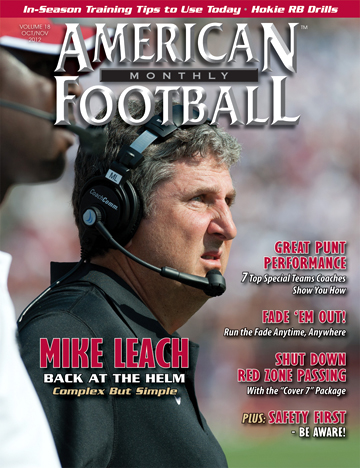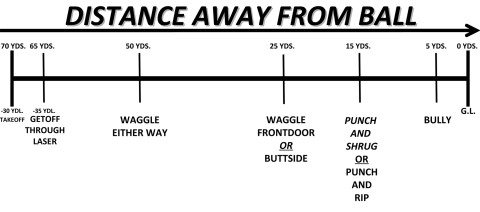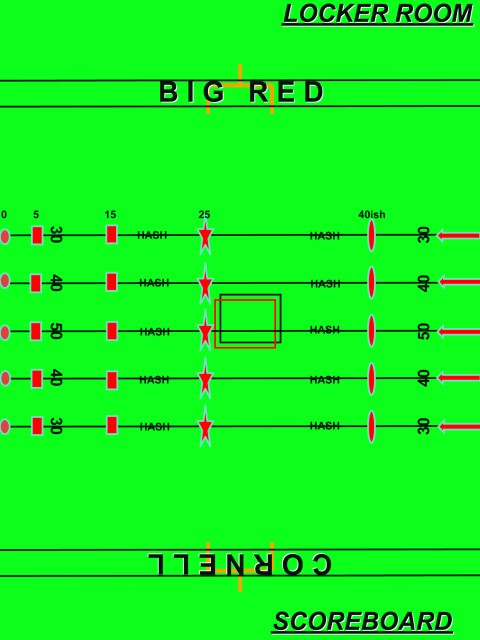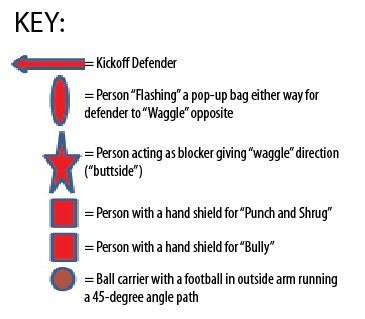Article CategoriesAFM Magazine
|
KICKOFF BLOCK DESTRUCTION PROGRESSIONby: Travis BurkettSpecial Teams Coordinator/Linebackers Coach • Cornell University © More from this issue Learning the proper fundamentals and techniques of kickoff coverage helps put your defense in a favorable position. In spite of the 2012 rule changes regarding special teams play, the kickoff remains one of the most pivotal plays in football. Most everyone who holds this view has a different reason. At Cornell, we feel that the kickoff’s importance lies in determining the drive start for our defense which, over time, is a direct indicator of defensive success and in setting the emotional tone for our entire team. We all hope to be able to recruit and develop a kicker that can kick the ball through the end zone on a regular basis. However, even with the rule change moving the kickoff spot to the 35, this may not always be the case. So, we will teach our block destruction progression the same way this season even with the kickoff spot rule change until the results from at least one full college season dictate otherwise.
Diagram 1. We have a base way that we teach block destruction to the entire special teams (See Diagram1) and it is important to touch on these fundamental tools before we talk about inserting them into the kickoff or adding different and specific techniques. There are a few fundamental premises that we try to teach and drill into our players concerning block destruction that are constantly emphasized. They include: 2. The only way to truly destroy a block, regardless of the tool you are using, is to stack the blocker vertically or to “get front to back”. The steps or tools of the block destruction continuum all have corresponding drill work and are taught and drilled before we even mention kickoffs or punts. We will not cover the specifics in this article but need them as a frame of reference. Although there is carryover directly from here to the kickoff progression, laying a general fundamental foundation separately in block destruction is imperative before applying the tools specifically to kickoffs or punts. Concerning schemes, only one schematic concept specific within the scheme of our kickoff coverage is necessary to be able to understand and possibly apply our kickoff block destruction progression. We number our people from left to right 1-10, (not including the kicker), and we will always keep the ball through the entire play between the 5 and 6. The specific is that the 1-5 will always keep the ball as tight as possible to their right shoulder and the 6-10 will always keep the ball as tight as possible to their left shoulder. It is always the ball that everyone will relate to both horizontally and, especially, vertically. What follows is our kickoff block destruction progression explained and diagramed for drill work based on kicking from the 35 to the goal line. This is regardless of an opponent’s overall scheme and any obvious man keys from a specific weekly game plan (See Diagram 2). Diagram 2. The first step on the kickoff for us is the “Get-off Through Laser” phase which takes place from the 35 and hopefully continues uninterrupted through the collision of what we call a “Fit” tackle. Before we can get to get-off, we have the “Takeoff” phase which takes place from the 30 to 35 and really just indicates the specific stance and start that we require the entire kickoff unit to implement. We feel that get-off through laser is very descriptive as it tells the players exactly what we want from them: a get-off sprint from the 35 that carries them at full speed from that point through the tackle. This also includes the “Laser”-ing of their path as tightly as possible width-wise and on the appropriate shoulder to where the kicker has actually placed the football. The first way we measure a player’s understanding of kickoff is if he is or is not immediately reacting to the ball once he hits the 35 with the foot of the kicker. This phase marries up with the first overall block destruction fundamental of “You are BFS.” Once our kickoff unit has tracked the ball and lasered their path accordingly, we will begin to almost immediately encounter the opponent’s blockers. We will not deal here with the nuances of “short-sets” by the frontline of the opponent KOR. However, that is exactly why the next phase is “Waggle Either Way”. We want our players to have the autonomy to practice what we preach and relate to the ball regardless of the nature or depth of the block. This principle is much more simply and safely applied when we are in a vertical region of between 50 and 25 yards away from the football. However, as players become more advanced, we have allowed individuals to waggle either way within 25 yards until they prove themselves wrong. A “waggle” is a violent full-speed movement that is used by the kickoff defender to evade the opponent’s block without breaking stride. We always “stem and stick” away from where we eventually want to go and then “dip and drive” the direction we intend to end up. As mentioned earlier, “stacking the block” or getting “front to back” are general block destruction keys but are especially imperative when implementing a waggle. The slightest shove or grab from the side by the opponent can drastically change the course of the kickoff defender and force him out of proximity to the football. As we decrease the vertical distance toward the ball and have completed a “front-line waggle”, the game changes as not only are the kickoff defenders and opponent blockers moving, but so is the ball. This severely decreases the amount of time we have to determine where we are and what tool to use. This is why from 25 to 15 yards away from the ball we force all but the most advanced players to “Waggle Front Door or Buttside” which translates to waggling towards the ball or to a blatant man-key from the opponent’s scheme. This is usually indicated by being away from (toward the buttside) the way the man is facing. Again, the skill level of the individual player is crucial to understand. Until a player can track and re-track the ball that is now moving, we force them to waggle buttside which in the case of drill work for this progression is also the way the ball will be moving. We feel that if you have a unit on the whole that is still waggling blocks between 25 and 15 yards away from the ball, the kickoff team will have a chance to be highly successful in both kickoff return yardage defense and the all-important opponent drive start average categories. We insist that our kickoff defenders make contact with proper leverage on any opponent blocker from 15 to 5 yards away from the ball. Of course, we will never fault a player for running through an open lane and making a big hit tackle. However, the cardinal rule here is that, if you have to think, then engage. The way we engage in this area is crucial and the key coaching point is to still maintain full speed. In this vertical zone, we will “Punch and Shrug or Punch and Rip” and both must be done while maintaining constant leg movement, gaining upper body separation, and keeping the head out of contact (eyes on the throat is our aiming point). The punch and shrug is a double-arm engagement with the punch violently shocking the blocker back and up while grabbing cloth. The shrug allows the defender to disengage when he throws the blocker down and away from the direction of the ball. The punch and rip is a tool that we teach in fundamental block destruction that our players can implement on kickoff. However, it is definitely an “only if you have to” because it takes significantly longer to execute. If we have a unit of kickoff defenders punching and ripping routinely, that usually means we are slowing down far too much or not getting any separation when we punch. Either of these are wasted movements if the defender loses his sight of the ball. A “Bully” is essentially a punch with no disengagement. When our kickoff personnel are from 5 to 0 yards away from the ball, the only tool allowed is the bully (the same open lane big hit tackle disclaimer applies here) as, in this close quarters, we will use speed and the violence of the punch to make the tackle without having to disengage until the last possible instant. When we bully, we are physically trying to knock the blocker back into the returner and not “pick a side.” This is what we are forcing the returner to do when we stay square. Along with our players that are bullying, we can then come off and make a tackle with the returner surrounded by the enemy with only one way to go. As with punch and shrug, the key to this tool is to trust in the acceleration of the feet and know that in this type of proximity, the returner will eventually come to you if you stay square and thick on the block.
Diagram 3.
We drill this entire progression at one time and aim to get every single member of the kickoff (including kickers) one repetition to each side (See Diagram 3). We will tell the defenders which way the buttside is and the ball carrier will match the buttside. In conjunction with this, when the defenders disengage off of their punch and shrug (we don’t allow punch and rip in this drill) it should marry up with the buttside and the way the ball carrier is going. Here are the key logistics and coaching points of the drill: We firmly believe that championship-level special teams from both a quantitative (league and national statistics) and qualitative (did we help the entire team play better?) perspective are founded on the teaching and learning of sound fundamentals and techniques. Those two areas demand effort and finish and, if inserted into simple and consistent schemes, usually give the players a great chance to achieve their goals. |
|
| HOME |
MAGAZINE |
SUBSCRIBE | ONLINE COLUMNISTS | COACHING VIDEOS |
Copyright 2024, AmericanFootballMonthly.com
All Rights Reserved








